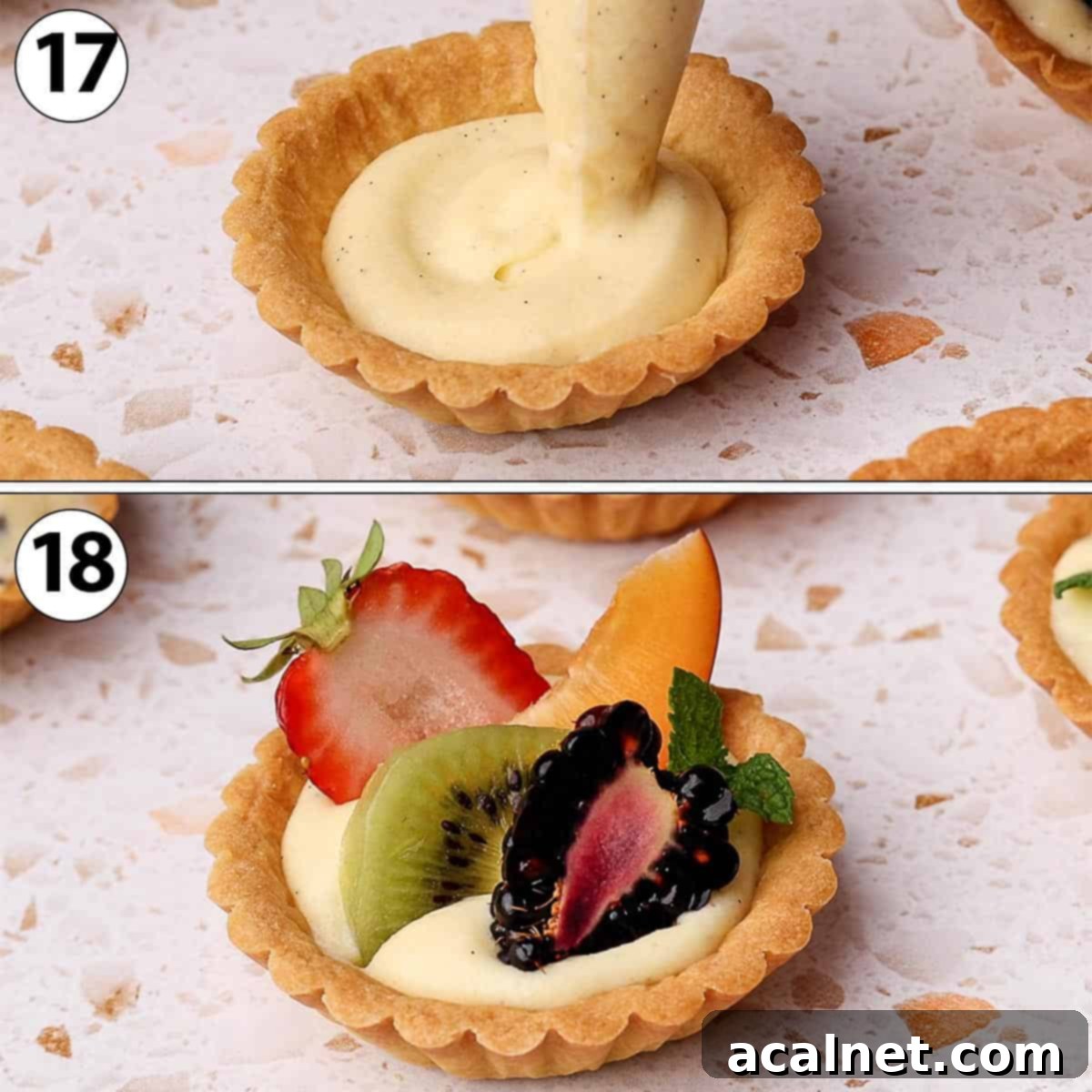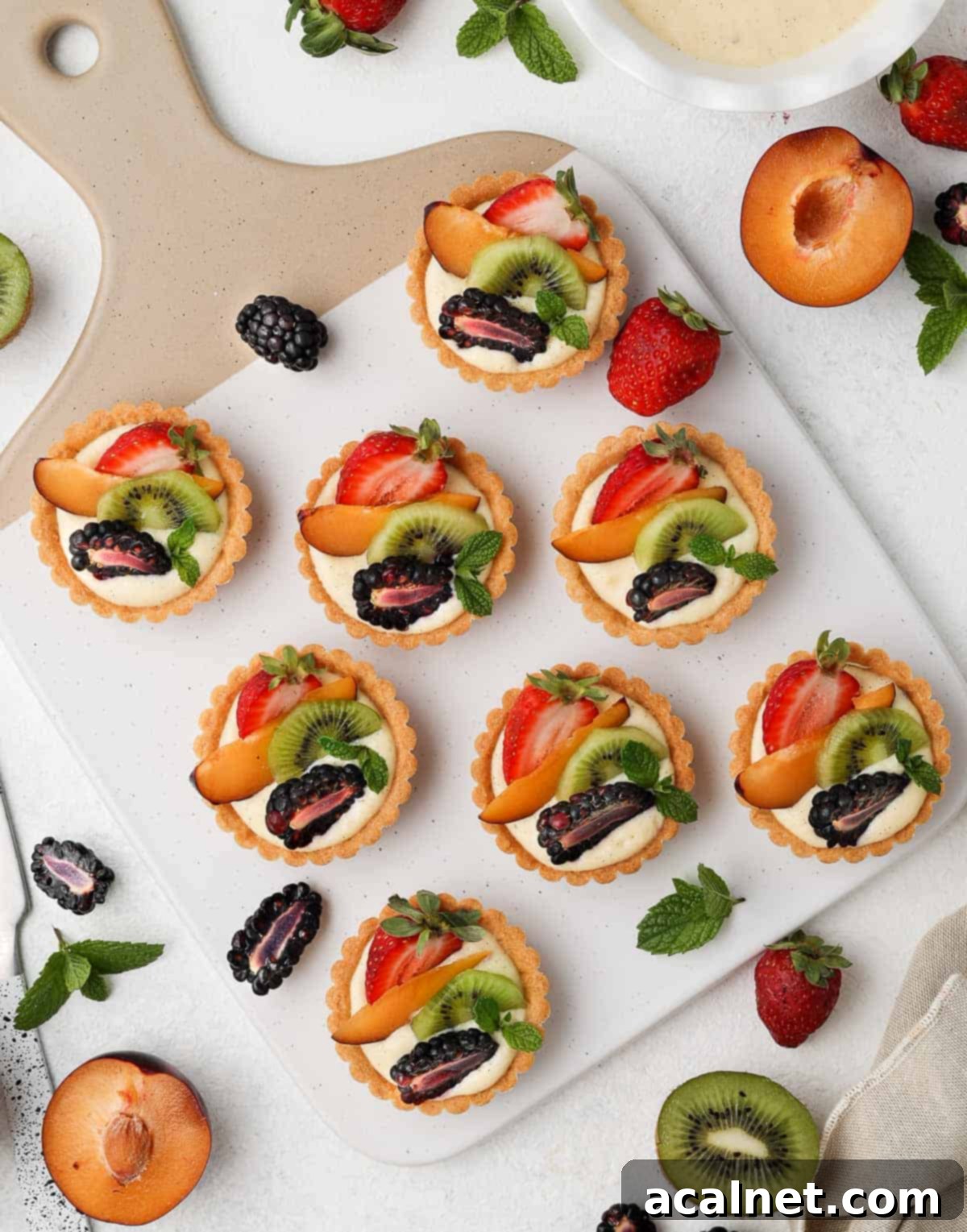Exquisite French Mini Fruit Tarts with Homemade Pastry Cream: Your Ultimate Guide
Indulge in the delightful elegance of these French Mini Fruit Tarts, a perfect bite-sized dessert that brings a touch of sophistication to any party or afternoon tea. Featuring perfectly golden, buttery, and irresistibly crunchy homemade tartlet shells, each one is generously filled with a velvety vanilla pastry cream (Crème Pâtissière) and crowned with an assortment of vibrant, fresh fruits. This comprehensive guide will walk you through every step, ensuring your mini tarts are not just visually stunning but also burst with exquisite flavor and texture.

[feast_advanced_jump_to]
Why You’ll Adore These Mini Fruit Tarts
There’s something inherently special about mini fruit tartlets that makes them the perfect choice for any special occasion. Whether you’re hosting an elegant afternoon tea, a festive party, or simply craving a sophisticated treat, these individual desserts never fail to impress. What makes this recipe truly stand out is the harmonious blend of textures and flavors it offers:
- Perfect Balance: Each tartlet combines the delightful crunch of a homemade shortcrust pastry shell with the luscious smoothness of a rich Crème Pâtissière, perfectly complemented by the natural sweetness and slight tang of fresh fruits. It’s a symphony of crunchy, creamy, sweet, and fresh in every bite.
- Unmatched Versatility: This recipe is incredibly adaptable, allowing you to customize it to your personal preferences or the season. Imagine a burst of mixed berries in summer, or the comforting warmth of poached pears or apples in winter. The vanilla custard filling itself can be swapped for other delectable options like a zesty Lemon Curd, a light cream cheese filling, indulgent Chocolate Cremeux, or a rich Chocolate Pastry Cream.
- Convenient Make-Ahead Components: One of the best features of these mini fruit tarts is that many elements can be prepared in advance. Both the buttery tartlet shells and the creamy vanilla custard can be made several days ahead, saving you valuable time. On the day of your event, all that’s left is the joyful task of assembling and garnishing – making entertaining a breeze!
These petite French desserts are not just treats; they’re an experience, promising a fancy yet approachable homemade touch that will leave your guests asking for the recipe.
Crafting Your Mini Fruit Tartlets: A Step-by-Step Guide
Creating these exquisite mini fruit tarts involves three main stages: preparing the crisp tartlet shells, whipping up the velvety pastry cream, and finally, assembling them with your chosen fruits. Each step is designed to be straightforward, leading you to a truly rewarding baking experience.
Perfect Mini Tart Shells from Scratch
The foundation of any great fruit tart is its shell. For these mini delights, we use a classic French Pâte Sablée, also known as French Shortcrust Pastry. This pastry is renowned for its tender, crumbly texture and rich buttery flavor, providing the perfect counterpoint to the creamy filling.

The ingredients for this delightful pie crust are simple: All-Purpose Flour (with a tiny pinch of salt for flavor balance), fine Icing Sugar (also known as powdered sugar, which gives a tender crumb), very cold Unsalted Butter, and one medium Egg. While it can certainly be made by hand, I find using a food processor makes the process incredibly quick and easy.
- Begin by placing the Flour, Salt, and Icing Sugar into the bowl of your food processor. Pulse for just a few seconds to ensure they are well combined and any small lumps of sugar are broken down.
- Photo 1: Add the very cold butter, which you’ve cut into small, even cubes. The coldness of the butter is key to a flaky, yet tender, pastry.
- Photo 2: Blend again for several seconds until the mixture resembles small, coarse crumbs. For this pastry, we’re aiming for very small, almost sand-like crumbs. This texture prevents excessive flakiness, ensuring a sturdy base for your filling.
- Photo 3: Incorporate the Egg into the mixture. The egg acts as a binding agent, bringing the dough together and adding richness.
- Photo 4: Continue mixing until a rough, slightly crumbly dough begins to form. It might not look perfectly smooth in the food processor, but that’s exactly what you want. To check if it’s ready, press a small handful of crumbs between your fingers; if they stick together to form a cohesive dough, it’s perfect. If the dough still seems too dry or isn’t coming together, add a tablespoon of very cold water at a time, pulsing briefly after each addition, until the desired consistency is achieved.

- Turn the pastry dough out onto a large sheet of baking paper. Gently work it for just a few seconds to bring it together into a smooth ball. Overworking the dough can lead to a tough crust, so keep handling to a minimum.
- Photo 5: Cover the dough with a second sheet of baking or parchment paper. Using a rolling pin, roll the pastry evenly to a thickness of approximately 4 mm (1/8 inch). Rolling between two sheets of paper prevents sticking and keeps your workspace clean.
- Transfer the rolled dough (still between the paper) onto a flat tray and refrigerate for at least one hour, or ideally up to 24 hours. Chilling is crucial for the butter to firm up, preventing shrinkage and ensuring crisp shells.
- Photo 6: Once thoroughly chilled, remove the top layer of baking paper. Use a round cutter slightly larger than your tartlet pans to cut out pastry circles. I recommend using Mini Tart Pans that are about 7 cm (2.75 inches) wide, and cutting pastry disks of about 10 to 12 cm (4 to 4.75 inches) in diameter to allow for the sides.
- Alternatively, if you don’t have mini tart pans, you can successfully make these tartlet shells in a regular muffin pan (or even a mini muffin pan). Detailed instructions for this method are available in my dedicated tartlet shells recipe!
- Photo 7: Carefully press the pastry circles into the molds, ensuring they line the base and sides without stretching. Trim any excess pastry from the edges. For a professional finish, you can use a straw or similar utensil to gently press into the fluted edges, defining their shape. Finally, prick the bottom of each pastry shell with a fork to prevent it from puffing up during baking. Gather any leftover pastry, re-roll, chill, and use for more tartlets.
Temperature Check: The dough’s temperature is vital. If it’s too cold, it will be stiff and prone to breaking – simply let it sit at room temperature for a few minutes. If it becomes too warm, the butter will soften too much, making the pastry sticky and difficult to handle; in this case, return it to the fridge for a quick chill.
- Place the lined tartlet shells back into the fridge for at least another hour, or up to 24 hours. This second chill is critical for maintaining their shape during baking.
- Preheat your oven to 160°C (325°F). While the oven preheats, transfer the tartlet shells to the freezer for a final quick chill. This thermal shock helps prevent shrinkage.
- Photo 8: Line each cold pastry crust with a small piece of baking paper, then fill with baking weights, dried beans, or rice. These weights prevent the pastry from bubbling up. Bake for 15 minutes, then carefully remove the weights and baking paper. Return the shells to the oven for an additional 10 minutes, or until they are golden brown and crisp.
- Remove from the oven and allow them to cool completely in the molds before attempting to remove them. Once cool, the crusts should effortlessly slide out of the tart molds, ready for their filling.
Luxurious Pastry Cream Filling (Vanilla Custard)
The heart of these mini fruit tarts is the traditional French Pastry Cream, or Crème Pâtissière. This rich, smooth, and intensely vanilla-flavored custard provides a creamy contrast to the crisp shells and fresh fruit. It’s made with wholesome ingredients: Full Cream / Whole Milk, aromatic Vanilla (preferably fresh vanilla bean or a high-quality vanilla paste), golden Egg Yolks, fine Caster Sugar, and thickening Cornstarch.
You can begin preparing the pastry cream while your tartlet shells are chilling in the fridge, as the cream also benefits from resting and cooling down completely before assembly.

- Photo 9: If you’re using a fresh Vanilla Bean, carefully slice it in half lengthwise with a sharp knife. Scrape out the tiny, fragrant seeds.
- Photo 10: Pour the milk into a medium-sized saucepan. Add both the scraped vanilla seeds and the empty vanilla pod to the milk. Gently heat the milk over low heat, bringing it just to a simmer. Once simmering, remove from heat and cover the saucepan with a lid. Allow the vanilla to infuse into the milk for about 10 to 15 minutes. This step extracts maximum flavor from the vanilla bean.
- If you opt for Vanilla Paste instead, simply add it directly to the milk and heat. No infusion time is necessary. I generally avoid vanilla extract for pastry cream as its flavor tends to be less potent and less authentic compared to a bean or paste.
- Photo 11: While the vanilla infuses, prepare your other ingredients. In a separate, heat-proof bowl, whisk together the Caster Sugar and Egg Yolks until the mixture is pale yellow and smooth.
- Photo 12: Sift the Cornstarch into the egg yolk mixture. Whisk until it is fully incorporated and the mixture is completely smooth, with no lumps.

- Photo 13: Once the milk has infused, remove the vanilla pod. Slowly and gradually pour about a third of the warm milk over the egg and sugar mixture while continuously whisking. This crucial step, known as tempering, slowly raises the temperature of the egg yolks, preventing them from scrambling when they hit the hot milk on the stove.
- Photo 14: Pour the tempered egg mixture back into the saucepan with the remaining warm milk.
- Photo 15: Return the saucepan to low heat and cook for approximately 5 minutes, making sure to continuously whisk the mixture. This constant stirring prevents the cream from sticking to the bottom and burning. Continue cooking until the pastry cream thickens significantly, reaching a rich, pudding-like consistency.
- Important Note: It’s vital not to let the mixture boil vigorously, as this can cause the eggs to curdle. If you notice any small lumps, you can optionally pour the finished cream through a fine-mesh sieve for an extra-smooth texture.
- Photo 16: Transfer the hot pastry cream into a clean bowl. Immediately cover the surface of the cream with plastic wrap, ensuring it touches the cream directly to prevent a skin from forming. Place the bowl in the fridge to cool down completely for about 1 to 2 hours.
- Pro Tip: To accelerate the cooling process, spread the hot pastry cream into a large, shallow pan (like a brownie pan) instead of a deep bowl. This increases the surface area, allowing it to cool much faster.
Assembling Your Gorgeous Fruit Tarts
The final and most enjoyable part of creating these mini fruit tarts is bringing all the prepared components together. This is where your creativity shines as you arrange the fresh fruits into beautiful patterns.

- First, wash and prepare your selection of fresh fruits. For a visually appealing assortment, I often use Strawberries (halved), Plums (cut into thin strips), Kiwi Fruit (halved and then thinly sliced), and Blackberries (halved). Feel free to choose your favorites and cut them into shapes that will fit elegantly onto the mini tartlets.
- Photo 17: Once the Pastry Cream is thoroughly chilled and firm, transfer it to a pastry bag. If you don’t have a pastry bag, a zip-top bag with the corner snipped off works just as well. Cut a generous tip off the bag and pipe the cream into each tartlet shell, filling it approximately halfway. Gently tap the filled shells on a hard surface a few times to evenly spread the cream and release any air bubbles.
- Photo 18: Carefully arrange your prepared fresh fruits over the pastry cream. Lightly press them into the cream to secure them in place. For an extra touch of freshness and color, finish with a few small leaves of fresh mint.
- Optional Glaze: For a beautiful shine and to help preserve the freshness and color of the fruits, you can optionally brush a thin layer of apricot preserves or jam (thinned with a little bit of water) over the assembled mini fruit tarts. This creates a lovely glaze. Personally, I often prefer to assemble the tarts just before serving and skip the glaze, as I enjoy the natural look and to avoid adding any unnecessary extra sweetness.

Frequently Asked Questions About Mini Fruit Tarts
While homemade crusts offer an unparalleled buttery flavor and texture, you can certainly use pre-made pie crusts or tartlet shells if you’re short on time. Many grocery stores offer good quality options that can still result in a delicious dessert. Alternatively, if you plan ahead, you can bake a batch of homemade shells and keep them in the freezer for up to a couple of months, allowing you to quickly assemble these tarts whenever a craving strikes.
While a pudding mix might seem like a quicker alternative, I wholeheartedly recommend making your own homemade pastry cream. The difference in taste and texture is truly incomparable. Homemade custard boasts a richer, smoother, and more authentic vanilla flavor that store-bought mixes simply can’t replicate. Furthermore, making your own allows you to control the level of sweetness, ensuring your dessert is perfectly balanced and not overly sugary.
The beauty of mini fruit tarts lies in their versatility! You can use virtually any fresh fruit based on seasonal availability and your personal preferences. Fresh berries like vibrant Strawberries, sweet Raspberries, and juicy Blueberries are always fantastic choices. For a zesty twist, consider citrus segments like oranges or mandarin oranges, which add a refreshing brightness. Don’t forget to think about color for visual appeal: the striking green of Kiwi Fruits, the rich purples of Blackberries, or the warm orange hues of Plums, Peaches, or Nectarines can make your tartlets truly pop!
Absolutely! If you don’t have mini tart pans with removable bottoms, you have several options. You can use a regular Muffin Pan to create these mini fruit tart shells, following the instructions in my dedicated Mini Tart Shells recipe. Additionally, small perforated Pastry Rings, similar to those I use for my Strawberry Custard Tarts or Pear Frangipane Tartlets, also work exceptionally well. While silicone molds are available, I personally don’t recommend them for pastry as metal molds generally yield a crisper, more evenly baked crust.
Shrinkage is a common issue, but easily preventable! The key steps are proper chilling and blind baking at the correct temperature. Ensure your pastry dough is well-chilled for at least an hour (or longer) before rolling and again after lining the pans. This allows the gluten to relax and the butter to firm up. Additionally, placing the tartlets in the freezer briefly just before blind baking provides a thermal shock that locks their shape. Always use baking weights during the initial blind bake, and ensure your oven temperature isn’t too high.
Using a pastry bag with a round tip (or simply snipping the end off the bag) is the easiest way to achieve a neat and even distribution of cream. Make sure your pastry cream is thoroughly chilled before piping, as this will give it the necessary firmness. If you don’t have a pastry bag, a large spoon or an offset spatula can also be used to carefully fill the shells, though it might take a bit more patience to achieve a smooth finish.

Pro Tips & Troubleshooting for Perfect Tarts
- The pastry cream is too liquid: If your pastry cream seems too thin after cooking, it likely wasn’t cooked long enough for the cornstarch to fully activate. Remember that it will also thicken considerably as it chills in the fridge. If it’s still too runny after chilling, you can gently reheat it over low heat, whisking constantly, and cook for a few more minutes. For future batches, consider increasing the quantity of cornstarch by just a small amount (e.g., an additional 5-10 grams).
- The pastry cream is too thick: This can happen if you’ve used very large eggs, too much cornstarch, or cooked the cream for an extended period. To fix it, simply whisk in a dash of cold milk (one tablespoon at a time) until you achieve your desired silky-smooth consistency.
- How to keep fruit tarts from getting soggy: A common concern! The simplest and most effective way to prevent a soggy bottom is to assemble your fruit tartlets just before serving, or as close to serving time as possible. Another excellent trick is to brush the partially baked tartlet shells with a thin layer of egg white (whipped until frothy) in the middle of their baking time. This creates a protective, thin skin on the pastry, acting as a barrier against moisture from the cream filling.
- How to make sure the tartlet shells don’t shrink or collapse when baked: Patience and cold temperatures are your best friends here. Ensure you properly rest and chill the pastry dough multiple times – after mixing, after rolling, and after lining the molds. Baking on a slightly lower heat also helps. The goal is for the gluten in the dough to be as relaxed as possible and the butter to be thoroughly cold, preventing the dough from contracting in the oven.
- Keeping the fruits fresh for longer: While I personally prefer the natural look and taste of fresh fruit without an added glaze (to avoid unnecessary sweetness), using a neutral or fruit glaze is the most effective way to keep your fruits looking vibrant and fresh for extended periods. A fruit glaze is typically made by gently warming fruit jam or preserves (like apricot) with a small amount of water until it’s a brushable consistency.
Storing & Freezing Your Mini Fruit Tarts
Proper storage is key to enjoying your delicious mini fruit tarts at their best, or for planning ahead:
- Tartlet Shells: Unbaked tartlet shells (lined in their pans) can be kept in the fridge, well-covered, for up to 24 hours. Once baked, the empty shells will last for about 2 days at room temperature when stored in an airtight container. For longer storage, you can freeze them, preferably unbaked, for up to 2-3 months for the best texture when eventually baked.
- Pastry Cream: The vanilla pastry cream can be stored in the fridge for up to three days. Always ensure it’s covered directly on the surface with plastic wrap to prevent a skin from forming and to keep it fresh. However, for optimal flavor and texture, it is best used within 24 hours of preparation.
- Assembled Mini Fruit Tarts: Once the tartlets are assembled with the fresh fruits and pastry cream, they are best served immediately. If you have leftovers, they can be stored in the fridge for an additional two days. Keep in mind that the fruits may start to lose some of their crispness and shine over time, which is why fresh assembly is always recommended for presentation.

Discover More Delectable Tartlet Recipes
If you’ve fallen in love with these mini fruit tarts, explore other delightful tartlet creations from my collection:
- Raspberry Chocolate Tartlets
- Lemon Curd Tartlets
- Orange Tartlets
- Mini Chocolate Tarts
- Mini Lemon Meringue Tarts
- Chocolate Orange Tartlets
- Salted Caramel Tartlets
- Mini Chocolate Caramel Tarts
- Mini Butterscotch Tartlets
Made this recipe?
Let us know if you liked it by leaving a comment below, and tag us on Instagram @a.baking.journey with a photo of your creation!
Full Recipe Details

Mini Fruit Tarts
Print Recipe
Ingredients
Tartlet Shells
- 250 gr (1 2/3 cup) Plain / AP Flour
- 50 gr (1/2 cup) Icing Sugar
- 1 pinch Fine Table Salt
- 120 gr (1/2 cup) Unsalted Butter, very cold
- 1 medium Egg
Vanilla Pastry Cream
- 375 ml (1 1/2 cup) Full Cream / Whole Milk
- 1 Vanilla Bean, or 2 teasp Vanilla Paste
- 3 Egg Yolks, medium size, at room temperature
- 30 gr (2 1/2 tablesp.) Caster Sugar
- 30 gr (3 tablesp.) Cornstarch
Fruit Topping
- 1 Kiwi Fruit
- 10 Blackberries
- 10 Strawberries
- 1 Plum
- Fresh Mint, to taste, optional
Instructions
Tartlet Shells
- Place the sifted Flour, Icing Sugar and Salt in the bowl of your food processor. Pulse for a few seconds to mix, then add the very cold Butter cut into small cubes. Mix until you get fine crumbs of butter (see note 1).
- Add the Egg and mix until a rough dough starts to come together (see note 2).
- Place the pastry over a large sheet of baking paper and bring together into a ball. Cover with a second sheet of baking / parchment paper then roll to a thickness of about 4 mm (1/8 inch). Put in the fridge to rest and chill for at least 1 hour, or up to 24 hours.
- Remove the baking paper and cut out disks of pastry that are a bit larger than the tartlet pans you are using (see note 3). Line the tartlet pans with the pastry, pressing gently on the sides to slide it down (see note 4) and cut off any excess. Dock the bottom of the pastry with a fork. Leftover pastry can be re-rolled, chilled and used to make more tartlets.
- Place the tartlets shells back in the fridge to chill for at least one hour, or up to 24 hours then preheat your oven on 160’c/325’f. Place the shells in the freezer while the oven is preheating.
- Cover each crust with a little bit of baking paper then fill with baking weights, dried beans or rice. Bake for 15 minutes then remove the weights and baking paper and bake for an additional 10 minutes. Leave to cool down completely.
Pastry Cream Filling
- Place the Milk in a small saucepan. Cut the vanilla bean in half, scrap the seeds then place both the seeds and the bean in the milk. Turn on low heat and bring to a simmer. Turn off the heat, cover the sasucepan with a lid and leave to infuse for 10 to 15 minutes (see note 5).
- In a seperate heat-proof bowl, whisk the Egg Yolks and Sugar until foamy. Add the Cornstarch (preferably sifted) and whisk until incorporated and smooth.
- Carefully pour the warm milk over the Yolk/Sugar while continuously whisking (see note 6). When all smooth, transfer the whole preparation back in the saucepan and turn on low heat.
- Keep whisking on low heat until the cream starts to thicken – about 5 minutes (see note 7). Transfer into a clean bowl or large shallow pan and cover with plastic wrap touching the surface. Place in the fridge to chill for about 1 hour.
Assembling the tarts
- Wash and prepare the fresh fruits: cut the Strawberries and Blackberries in half, and the Plum and Kiwi Fruit into thin slices.
- Place the chilled Pastry Cream in a pastry bag and cut off the tip (see note 8). Pipe the cream inside the tartlet shells, about halfway up. Gently tap the shells on a hard surface to spread out the cream.
- Place the fresh fruits over the cream, pressing them in slightly so secure them. Finish with some fresh mint. Keep in the fridge until ready to serve – preferably as soon as possible.
- Optionally, brush a neutral glaze or fruit glaze over the fruits.
Video
Would you like to save this recipe?
We’ll email this post to you, so you can come back to it later!
Notes
Both the shells and pastry cream can be prepared in advance – see Storing & Freezing section above.
- The larger the crumbs, the flakier the pastry will be. In this case, we do not want too much flakiness so make sure the crumbs are very small.
- Don’t worry if it seems crumbly, it will come together when you roll it. To know the pastry has been mixed enough, press together some of the crumbs in your hand. If they stick together and turn into a smooth dough, it is ready. If after mixing the dough still does not seem to be coming together, you might have to add a little bit of cold water (one tablespoon at the time). It could happen if the egg you used was too small.
- I used these Mini Tart Pans that are 7 cm (1/4 inch) wide and cut out the disks of pastry to be about 10 to 12 cm (3/8 to 1/2 inch) wide.
- Optionally, use a stiff straw (or similar utensil) to press on each fluted edge in order to define their shape more. If the pastry dough seems a bit stiff, let it come back to room temperature first. The butter will soften and it will be easier to line the tins. If the pastry become too soft and starts to break, put it back in the fridge for a few minutes.
- If using Vanilla Paste, you do not need to let it infuse in the milk.
- This is to temper all the ingredients and make sure the eggs don’t burn or curd once placed on the stove.
- Always work with low heat to avoid burning the cream and/or overcooking the eggs. It will take longer to thicken, but it is the best way to get the perfect creamy texture without any lumps.
- You could also just scoop the cream into the shells or use a spoon if preferred.
Nutrition (per serving)
